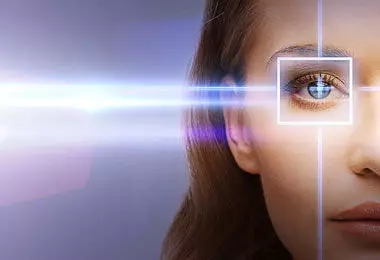What is amblyopia?
Amblyopia is poor vision in an eye that did not develop normal sight during early childhood. It is sometimes called “lazy eye.”
When one eye develops good vision while the other does not, the eye with poorer vision is called “amblyopic.” Usually, only one eye is affected by amblyopia, but it is possible for both eyes to be “lazy.”
The condition is common, affecting approximately two or three out of every 100 people. The best time to correct amblyopia is during infancy or early childhood.
What causes amblyopia?
It is caused by any condition that affects normal use of the eyes and visual development. In many cases, the conditions associated with it may be inherited.
Amblyopia has three major causes:
1.) Strabismus (Misaligned Eyes):
It occurs most commonly with misaligned or crossed eyes. The crossed eye “turns off” to avoid double vision, and the child uses only the better eye. The misaligned eye then fails to develop good vision.
2.) Unequal Focus/Refractive Error:
Refractive errors are eye conditions that are corrected by wearing glasses. It occurs when one eye is out of focus because it is more nearsighted, farsighted, or astigmatic than the other.
The unfocused (blurred) eye “turns off” and becomes amblyopic. The eyes can look normal, but one eye had poor vision. This is the most difficult type of amblyopia to detect since the child appears to have normal vision when both eyes are open.
3.) Cloudiness in the normally clear eye tissue:
An eye disease such as a cataract (a clouding of the eye’s naturally clear lens) may lead to amblyopia. Any factor that prevents a clear image from being focused inside the eye can lead to development of it in a child. This is often the most severe form of amblyopia.
How is it treated?
To correct it, a child must be made to use the weak eye. This is usually done by patching or covering the strong eye, often for weeks or months.
Even after vision has been restored in the weak eye, part-time patching may be required over a period of years to maintain the improvement.
Glasses may be prescribed to correct errors in focusing. If glasses alone do not improve vision, then patching is necessary.
Amblyopia may also be treated by blurring the vision in the good eye with special eye drops or lenses to force the child to use the amobyiopic eye.
It is usually treated before surgery to correct misaligned eye, and patching is often continued after surgery as well.
If your ophthalmologist finds cataract or other abnormality, surgery may be required to correct the problem. An intraocular lens may be implanted. After surgery, glasses or contact lenses can be used to restore focusing while patching improves vision.
Amblyopia cannot usually be cured by treating the cause alone. The weaker eye must be made stronger in order to see normally. Prescribing glasses or performing surgery can correct the cause of it, but your ophthalmologist must also treat the amblyopia itself.



